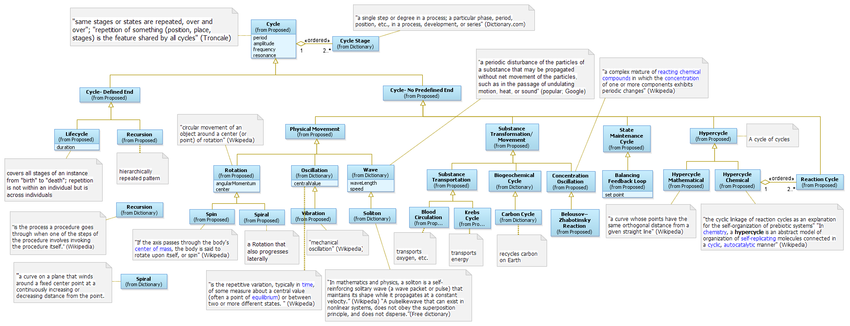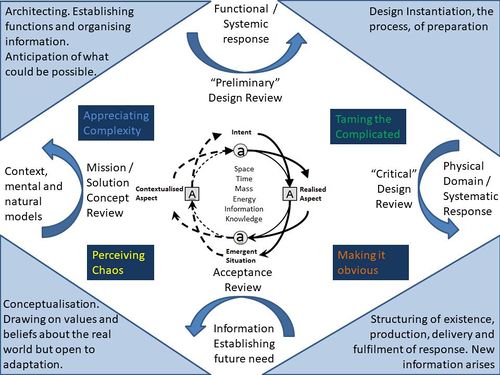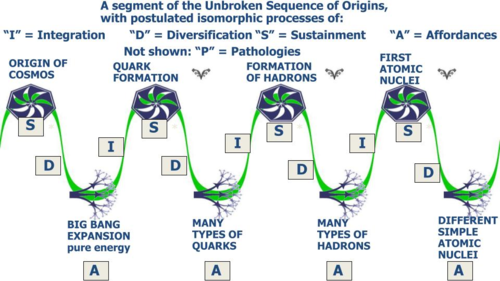Difference between revisions of "Cycles and the Cyclic Nature of Systems"
m (Text replacement - "<center>'''SEBoK v. 2.4, released 17 May 2021'''</center>" to "<center>'''SEBoK v. 2.5, released 15 October 2021'''</center>") |
m (Text replacement - "<center>'''SEBoK v. 2.6, released 13 May 2022'''</center>" to "<center>'''SEBoK v. 2.6, released 20 May 2022'''</center>") |
||
| (4 intermediate revisions by 3 users not shown) | |||
| Line 3: | Line 3: | ||
---- | ---- | ||
| − | This article is part of | + | This article is part of [[The Nature of Systems]] knowledge area (KA). "Cycle" is one of many concepts within {{Term|General System Theory (glossary)}} that have been studied within {{Term|Systems Science (glossary)}}. A {{Term|Cycle (glossary)}} is “a series of events that are regularly repeated in the same order; or move in or follow a regularly repeated sequence of events” according to the Oxford English Dictionary (2020). Cycles "define and make things. Equally things contain Cycles.” (Volk 1995) Mobus and Kalton describe a cycle as a temporary pattern (2015). The Foundation for the Study of Cycles describe a cycle as, "A series of events that is regularly repeated in the same order. The longer and more regular the series is repeated, the more predictable it becomes, until it cannot reasonably be considered a coincidence.” (2020) “Circularity is the essence of the early notion of feedback (circular causality). The notion of circularity is found in recursive computation (the use of DO loops, for example)”. (Krippendorf 1984) |
This article illustrates a General System Concept and its patterns of measurable instantiation. Additionally a number of frameworks that incorporate cyclic behaviour are highlighted and the pattern of relationships between these models, the phases of system emergence and the practice of system engineering are illustrated. | This article illustrates a General System Concept and its patterns of measurable instantiation. Additionally a number of frameworks that incorporate cyclic behaviour are highlighted and the pattern of relationships between these models, the phases of system emergence and the practice of system engineering are illustrated. | ||
| Line 85: | Line 85: | ||
---- | ---- | ||
| − | <center>[[ | + | <center>[[Types of Systems|< Previous Article]] | [[Foundations of Systems Engineering|Parent Article]] | [[Systems Science|Next Article >]]</center> |
[[Category:Part 2]] | [[Category:Part 2]] | ||
[[Category:Topic]] | [[Category:Topic]] | ||
| − | <center>'''SEBoK v. 2. | + | <center>'''SEBoK v. 2.6, released 20 May 2022'''</center> |
Revision as of 03:02, 18 May 2022
Lead Author: Gary Smith, Contributing Authors: Olaf Brugman, Helene Finadori, John Kineman, Tom Marzolf, George Mobus, Peter Tuddenham, Lynn Rasmussen, Hillary Sillitto, William Smith, Len Troncale, Tyler Volk
This article is part of The Nature of Systems knowledge area (KA). "Cycle" is one of many concepts within general system theory that have been studied within systems science. A cycle is “a series of events that are regularly repeated in the same order; or move in or follow a regularly repeated sequence of events” according to the Oxford English Dictionary (2020). Cycles "define and make things. Equally things contain Cycles.” (Volk 1995) Mobus and Kalton describe a cycle as a temporary pattern (2015). The Foundation for the Study of Cycles describe a cycle as, "A series of events that is regularly repeated in the same order. The longer and more regular the series is repeated, the more predictable it becomes, until it cannot reasonably be considered a coincidence.” (2020) “Circularity is the essence of the early notion of feedback (circular causality). The notion of circularity is found in recursive computation (the use of DO loops, for example)”. (Krippendorf 1984)
This article illustrates a General System Concept and its patterns of measurable instantiation. Additionally a number of frameworks that incorporate cyclic behaviour are highlighted and the pattern of relationships between these models, the phases of system emergence and the practice of system engineering are illustrated.
Introduction
Movement and evolution are fundamental in the dynamics of nature and thus cycles are evident, almost or even absolutely, everywhere. (Wikipedia.org 2020)
Due to its generality, "cycle" is a key concept for Systemists, in our communication, in our thinking, and our engagement with systems. The repetition of natural law and associated behaviour in mechanical systems, and other examples of objective-subjective or system-context cycles are important in systems science. Cyclical phenomena are studied in several different ways in different sciences, e.g. dynamics, biology, sociology, cosmology etc. Cyclical dynamics are ubiquitous and thoroughly characterized:
- Cycles of system renewal in ecology (Allen & Hoekstra 1992; Gunderson 2013)
- Cycles of planning and intervention in social science (Sankaran et al. 2015)
- Business (Senge 2006)
- Cybernetics (Krippendorf 1984)
- Environmental management and decision support (Bell 2012)
- Coherence/decoherence or entanglement cycles in quantum mechanics (Hsiang & Ford 2009)
- Modelling relations in living systems (Rosen 1991a; b)
Cycles are evident in a number of Archetypes both natural and engineered as summarized in the following diagram:

There are a number of well-established frameworks that incorporate cyclic phenomenon – Cynefin (situation), Panarchy (social/ecological), OODA (situation), Spiral Model (engineer development), The Problem / Solution System and Action Research (Plan, Act, Observe, Reflect). It is also evident in Peter Senge's first law of The Fifth Discipline, “today's problems come from yesterday's solutions. The problem you inherited today is likely the result of a series of solutions that seemed right at the time made by people that are probably no longer around.” (Senge 2006)
The work of Robert Rosen, taken forward by John Kineman on Relational Theory is working towards a mathematical underpinning of the dual-aspect (system and context in cyclical relation) “Holon” and as a framework for System Research (Kineman 2017).
Cycle is respected and instantiated in practice with the Lifecycle Management of software, physical artefacts, services and enterprises when Applying the System Approach. Indeed, it is evident in the very structure of the Scientific Method (iterative cycle) and underpins the application of technical management in the development of systems and solutions. Systems Engineering itself is a cycle consisting of various project cycle stages (Forsberg, Mooz and Cotterman 2005). Cycles of systems may affect other systems’ cycles or be affected by those other systems’ cycles. Therefore, understanding the design, creation and maintenance of cycles and understanding how they are affected by other systems’ cycles is a key tool for managing complexity.
Within a cycle, a recurrent pattern of Isomorphic processes has been postulated and systematically studied (Troncale, 1978). Below is a diagram of the first 4 of 80 detailed Integration to Diversification cycles from the Big Bang to our societal cultural artefacts. Dr. Troncale has collected reprints from seven major conventional sciences that indicate that cycling (or its subtypes) is contained in over 250 natural phenomena studied by the sciences. Having an understanding of this pattern and the processes that result in the cyclic nature of systems may allow systemists to better identify, categorize, design for, maintain and utilize lifecycle processes with greater understanding of the underlying principles to guide our practice and consequently increase fidelity in application.
This diagram adapted from the work of Len Troncale ISSS Cycle Contributions, https://www.isss.org/sebok-contribution/ illustrates an observed recurrent waveform pattern that spans origins across the entire landscape of systems. “All living (even non-living) entities of the same class exhibit the same phases (form) in their life cycle – birth, maturation, death, dissolution” (Troncale 1978). Processes of “Affordances” – for new relationships, and “Sustainment” were added as a result of collaborative discussion.
References
Works Cited
Allen, T.F.H. & Hoekstra, T.W. (1992) Toward a Unified Ecology. Columbia University Press.
Bell, S. (2012) DPSIR = A Problem Structuring Method? An exploration from the “Imagine” approach. European Journal of Operational Research, 222, 350–360.
Daniel-Allegro B, Smith G.R. (2016). Exploring the branches of the system landscape, Les editions Allegro Brigitte D. ISBN 978-2-9538007-1-5.
The Foundation for the Study of Cycles. 2020. "Cycle" https://cycles.org/
Gunderson, L.H. (2013) Panarchy Synopsis: Understanding Transformations in Human and Natural Systems. Island Press.
Hsiang, J.-T. & Ford, L.H. (2009) Decoherence and Recoherence in Model Quantum Systems. International Journal of Modern Physics A, 24, 1705–1712.
Kineman, J.J. (2011) Relational Science: A synthesis. Axiomathes, 21, 393–437.
Krippendorff, K. (1984). An Epistemological Foundation for Communication. Journal of Communication 34(3), 21-36.
Oxford English Dictionary. 2020. s.v. "Cycle".
Rosen, R. (1991a) Beyond dynamical systems. Journal of Social and Biological Structures, 14, 217–220.
Rosen, R. (1991b) Life Itself: A Comprehensive Inquiry into the Nature, Origin, and Fabrication of Life. Columbia University Press.
Sankaran, S., Dick, B., Passfield, R. & Swepson, P. (2015) Effective Change Management Using Action Learning and Action Research. n/a, Lismore, NSW, Australia.
Senge, P.M. (2006) The Fifth Discipline: The Art & Practice of The Learning Organization, Revised&Updated. Doubleday, New York.
Wikipedia.org. 2020. "List of Cycles". https://en.wikipedia.org/wiki/List_of_cycles
Primary References
Forsberg, K., H. Mooz, H. Cotterman. 2005. Visualizing Project Management, 3rd ed. New York, NY, USA: J. Wiley & Sons.
Kineman, J.J. 2017. Chapter 2, Systems Research Framework, A Guide to Systems Research. Springer.
Mobus, G.E and M.C. Kalton. 2015. Principles of System Science. Springer.
Troncale, L.R. 1978. Nature’s Enduring Patterns. California State Polytechnic University.
Volk, T. 1996. Metapatterns. Columbia University Press.
Additional References
None.
Videos
Video presentations on the unbroken sequence of origins by Len Troncale and on Cycles by Tyler Volk and Gary Smith are available ISSS Cycle Contributions. https://www.isss.org/sebok-contribution/

